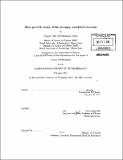Slave particle study of the strongly correlated electrons
Author(s)
Vaezi, Seyyed Mir Abolhassan
DownloadFull printable version (8.281Mb)
Other Contributors
Massachusetts Institute of Technology. Dept. of Physics.
Advisor
Xiao-Gang Wen.
Terms of use
Metadata
Show full item recordAbstract
Until three decades ago, our understanding of the condensed matter systems were based on two frameworks developed by Russian physicist Lev Landau: his theory of phase transition, and Fermi liquids. The Landau theory of phase transition and the Fermi liquid theory together, can successfully explain a wide range of phenomena from ferromagnetism and antiferromagnetism to the conventional superconductivity. However, in the last thirty years, many experiments including the fractional quantum Hall effect (QHE) have revolutionized our view of nature. For a system of electrons that is subject to a very strong interactions and/or strong correlations between electrons, these two frameworks may break down. There many phases of matter, e.g. spin liquids, that do not break any classical symmetry, but are separated by phase transition. These states has the so called topological order. Also, many of these states do not follow predictions of the Fermi liquid theory and have many exotic behaviors. A rather powerful technique to handle with these issues is the slave particle method. In the first part of this thesis, using a more general slave particle method we study the strongly correlated Hubbard model, whose ground state may represent a Fermi liquid state at two spatial dimensions. We study the phase diagram of this model and show that the gapped spin liquid can be realized on the both honeycomb and square lattices, within mean-field. We also investigate the effective low energy theory of these states. Some of them are subject to compact gauge fluctuations. We study instanton effect in them and show that instanton proliferation can destabilize some of them. Another interesting problem in which we are interested in is the copper based high temperature superconductors (HTSC). The parent state of cuprates materials (undoped case) is a Mott insulator whose ground state is proposed to be a spin liquid. Upon doping, many exotic phases appear, from high temperature superconductivity to the pseudogap phase with disjoint Fermi segments (Fermi arcs) instead of a closed Fermi surface, or the strange metal phase where the Fermi liquid theory breaks down and exhibits very unusual transport properties. The isotope effect in these materials is also very different from that of conventional superconductors. In the second part of this thesis we study the above mentioned problem in detail and explain them by appealing to the slave particle method.
Description
Thesis (Ph. D.)--Massachusetts Institute of Technology, Dept. of Physics, 2011. Cataloged from PDF version of thesis. Includes bibliographical references (p. 143-151).
Date issued
2011Department
Massachusetts Institute of Technology. Department of PhysicsPublisher
Massachusetts Institute of Technology
Keywords
Physics.